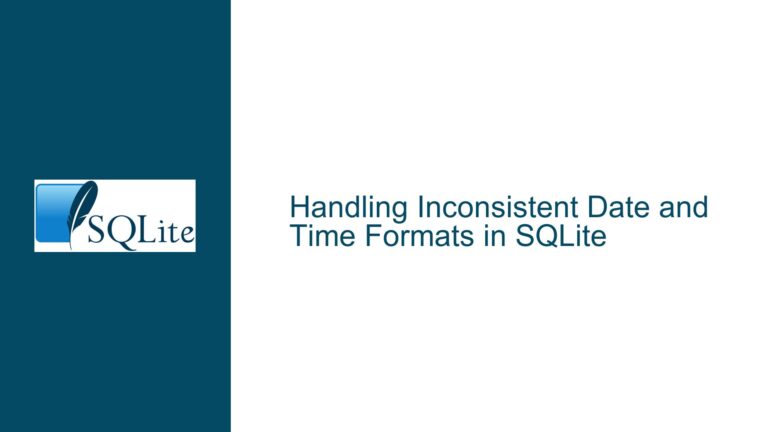Incorrect Query Results Due to Affinity Changes in CASE WHEN Expressions
Understanding the Impact of Affinity on CASE WHEN Expressions in SQLite
Issue Overview
The core issue revolves around the unexpected behavior of SQLite queries when using the CASE WHEN expression, particularly in scenarios where the expression’s result is compared with another value. The problem manifests when the CASE WHEN expression alters the affinity of the resulting value, leading to different comparison outcomes compared to a direct value reference. This discrepancy can cause queries to return inconsistent results, which is particularly problematic in scenarios where data integrity and consistency are paramount.
In the provided example, two test cases were executed. The first test case used a CASE WHEN expression to compare a value from one table with a subquery result. The second test case replaced the CASE WHEN expression with a direct column reference. Despite the logical expectation that both queries should return the same results, they did not. The first query returned a row, while the second query returned an empty result set. This inconsistency is directly tied to how SQLite handles data type affinity, especially in the context of the CASE WHEN expression.
Possible Causes
The root cause of this issue lies in SQLite’s type affinity system and how it interacts with the CASE WHEN expression. SQLite uses a dynamic type system where the type of a value is associated with the value itself, not the column in which it is stored. However, columns do have an affinity, which influences how values are stored and compared. When a CASE WHEN expression is used, the resulting value’s affinity can change based on the expression’s structure, leading to different comparison behaviors.
In the first test case, the CASE WHEN expression case when false then t4.c28 else t4.c31 end results in a value with no specific affinity. When this value is compared with the result of a subquery, SQLite applies the text affinity to the CASE WHEN result because the subquery’s result has text affinity. This leads to a string comparison, where '35.53' > '' evaluates to true, resulting in a row being returned.
In the second test case, the direct column reference t4.c31 has a numeric affinity. When this value is compared with the subquery result, SQLite applies numeric affinity to the subquery result. Since the subquery result is an empty string, applying numeric affinity does not change it, and the comparison 35.53 > '' evaluates to false, resulting in no rows being returned.
This behavior is consistent with SQLite’s type affinity rules but can be counterintuitive for developers who expect consistent comparison behavior regardless of the expression’s structure. The key takeaway is that the CASE WHEN expression can alter the affinity of the resulting value, which in turn affects how comparisons are performed.
Troubleshooting Steps, Solutions & Fixes
To address this issue, it is essential to understand how SQLite’s type affinity system works and how it interacts with different expressions. Here are the steps to troubleshoot and resolve the problem:
Identify the Affinity of the Expressions: The first step is to determine the affinity of the expressions involved in the comparison. In the case of the
CASE WHENexpression, the resulting value’s affinity depends on the structure of the expression. If the expression includes columns with different affinities, the resulting value may have no specific affinity, leading to unexpected comparison behavior.Explicitly Cast Values to Ensure Consistent Affinity: To ensure consistent comparison behavior, explicitly cast the values involved in the comparison to the desired data type. For example, if you want to perform a numeric comparison, cast both sides of the comparison to a numeric type. This can be done using the
CASTfunction in SQLite. For instance, you can modify the first test case as follows:SELECT * FROM t4 WHERE CAST((CASE WHEN false THEN t4.c28 ELSE t4.c31 END) AS REAL) > ( SELECT subq_0.c13 AS c0 FROM ( SELECT ref_0.c18 AS c13 FROM t3 AS ref_0 WHERE ref_0.c21 >= t4.c28 ) AS subq_0 ORDER BY c0 ASC LIMIT 1 );By casting the
CASE WHENresult toREAL, you ensure that the comparison is performed using numeric affinity, which should yield consistent results with the second test case.Avoid Ambiguous Affinity in Expressions: When constructing complex queries, avoid using expressions that can result in ambiguous or no affinity. If possible, simplify the expressions to ensure that the resulting values have a clear and consistent affinity. For example, instead of using a
CASE WHENexpression that mixes different affinities, consider restructuring the query to use direct column references or explicitly cast values.Test Queries with Different Data Types: To ensure that your queries behave as expected, test them with different data types and edge cases. This includes testing with empty strings, NULL values, and different numeric and text values. By doing so, you can identify any potential issues related to type affinity and address them before they cause problems in production.
Understand SQLite’s Type Affinity Rules: Familiarize yourself with SQLite’s type affinity rules and how they affect comparisons. SQLite’s documentation provides detailed information on how type affinity works and how it influences the storage and comparison of values. Understanding these rules will help you write more robust and predictable queries.
Use Consistent Data Types in Comparisons: When comparing values, ensure that both sides of the comparison have consistent data types. If one side of the comparison has a different affinity than the other, SQLite may apply implicit type conversion, leading to unexpected results. By ensuring that both sides of the comparison have the same affinity, you can avoid these issues.
Consider Using Explicit JOINs: In some cases, using explicit JOINs instead of subqueries can help avoid issues related to type affinity. JOINs can make the query structure clearer and reduce the likelihood of unexpected behavior due to implicit type conversion. For example, you can rewrite the test case using an explicit JOIN:
SELECT t4.* FROM t4 JOIN t3 ON t3.c21 >= t4.c28 WHERE t4.c31 > t3.c18 ORDER BY t3.c18 ASC LIMIT 1;This approach ensures that the comparison is performed directly between columns with known affinities, reducing the risk of unexpected behavior.
Monitor Query Performance: While addressing type affinity issues, it is also important to monitor the performance of your queries. Explicit type casting and complex expressions can sometimes lead to performance degradation. Use SQLite’s
EXPLAIN QUERY PLANstatement to analyze the execution plan of your queries and identify any potential performance bottlenecks.Document Query Behavior: When working with complex queries, document the expected behavior and any assumptions about data types and affinities. This documentation can serve as a reference for future development and troubleshooting, helping to ensure that any changes to the queries do not introduce unexpected behavior.
Leverage SQLite’s STRICT Tables: If you are using SQLite 3.37.0 or later, consider using STRICT tables to enforce strict data typing. STRICT tables require that each column has a specific data type, and any attempt to insert or update a value with an incompatible type will result in an error. This can help prevent issues related to type affinity by ensuring that all values in the table have the expected data type.
By following these steps, you can effectively troubleshoot and resolve issues related to type affinity in SQLite queries, ensuring that your queries return consistent and accurate results. Understanding how SQLite’s type affinity system works and how it interacts with different expressions is key to writing robust and reliable queries.






